Stephen Dowling
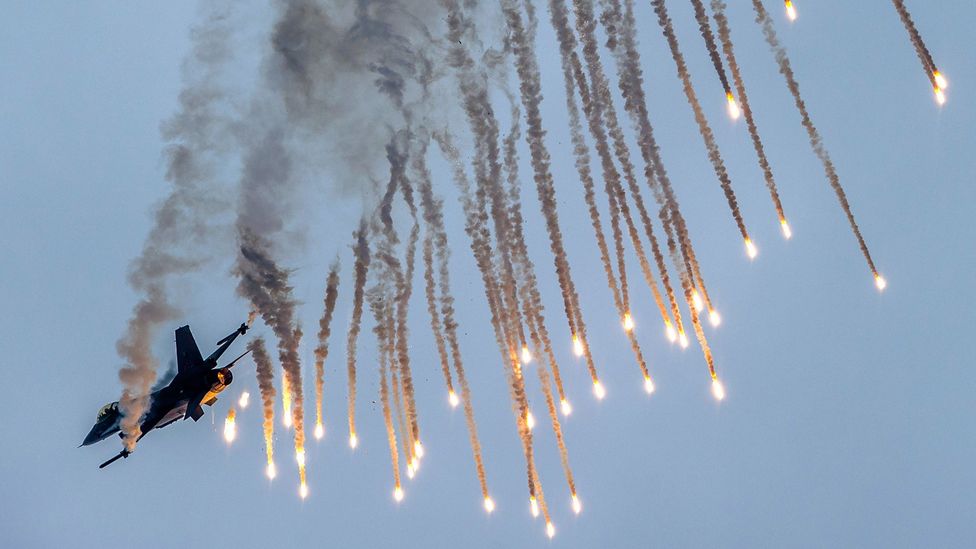
Were it not for one test pilot's quick thinking 50 years ago, the entire F-16 programme might never have made it past its first fateful flight.
When pilot Phil Oestricher climbed into the cockpit of the General Dynamics YF-16 prototype at Edwards Air Force Base in California on 20 January 1974, his mission was a relatively straightforward one – a high-speed taxi test where the aircraft would travel on the ground under the power of its own engine.
The YF-16 had only been unveiled to the public just over a month earlier. The first flight was not scheduled to take place until early February.
But the futuristic-looking jet had other ideas.
As Oestricher raised the aircraft's nose slightly, the YF-16 started rolling – so sharply that the aircraft's left wing and right tailplane hit the tarmac. "As Oestricher desperately fought to maintain control of his wild steed, the situation became increasingly dire as the YF-16 began to veer to the left," wrote the Seattle Post Intelligencer, reporting on the almost disastrous first flight. Oestricher realised he would have to depart from the planned test and get the aircraft airborne – and very quickly – before it crashed.
After some heart-stopping moments – at one point the aircraft dropped back down onto the runway – Oestricher managed to pick up enough speed for the prototype to take into the air and complete a dramatically unexpected six-minute-long flight before landing back at the base.
By virtue of his skillful flying, Oestricher had prevented disaster – and helped bring to life an aircraft that has become one of the most successful in living memory. Fifty years later, more than 4,600 F-16s have rolled off the factory lines, and production shows no sign of stopping.
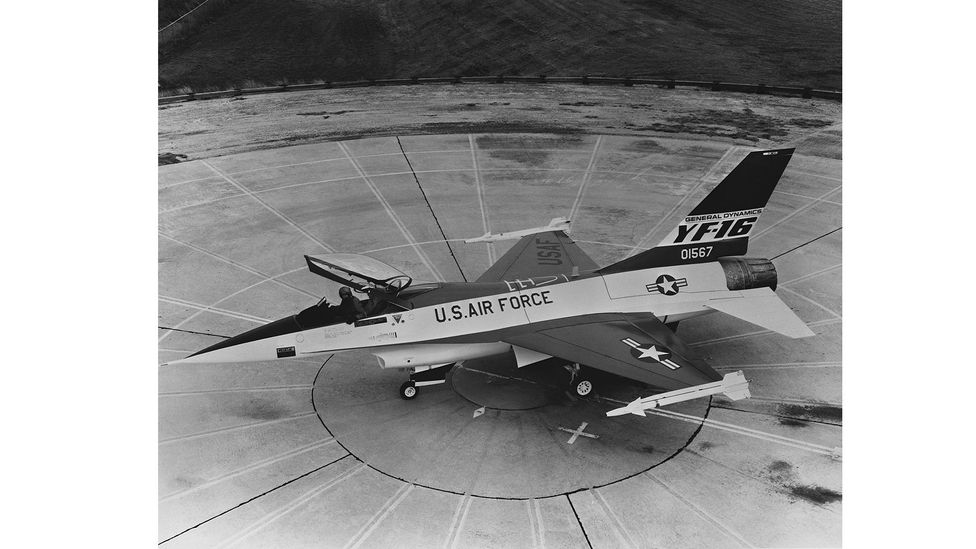
The first prototype, the YF-16, nearly crashed on its maiden flight
If Oerlicher hadn't managed to save the YF-16 from crashing on its first taxi test, there would be a sizeable F-16-shaped gap in many of the world's air forces. The aircraft's design has also had a lasting impact on civil aviation today too, providing the first use of technologies that are now commonplace in passenger airlines, for example.
At any moment of the day – or night – there's a good chance an F-16 is in the air, somewhere in the world. Since coming into service with US Air Force (USAF) in 1978, the F-16 has been flown by 25 other air forces, from Norway to Chile, Morocco to Singapore. In 2023, 45 years after it entered service, more than 800 remained flying with the USAF.
Designed as a small, light and ultra-nimble dogfighter, the F-16 has taken on more and more roles, from ground attack to anti-shipping to photo reconnaissance to hunting surface-to-air missile launchers. Since 2015, it's been the most numerous military fixed-wing aircraft in the world; more than 2,000 are thought to still be in active use globally today.
Ukraine's plea to the West for modern weapons to resist Russia's 2022 invasion has included calls for F-16s for its air force. Ukrainian pilots are currently training on F-16s in Denmark, and deliveries are due to start in the summer. In early January, Slovakia became the latest country to take delivery of its first F-16s, 50 years almost to the day since the aircraft first took to the air.
Keeping a frontline combat aircraft in service – let alone production – for five decades is no mean feat. The reasons why air forces still want F-16s is due to some truly innovative aspects of its design, and some hard lessons learned from air combat in the Vietnam War.
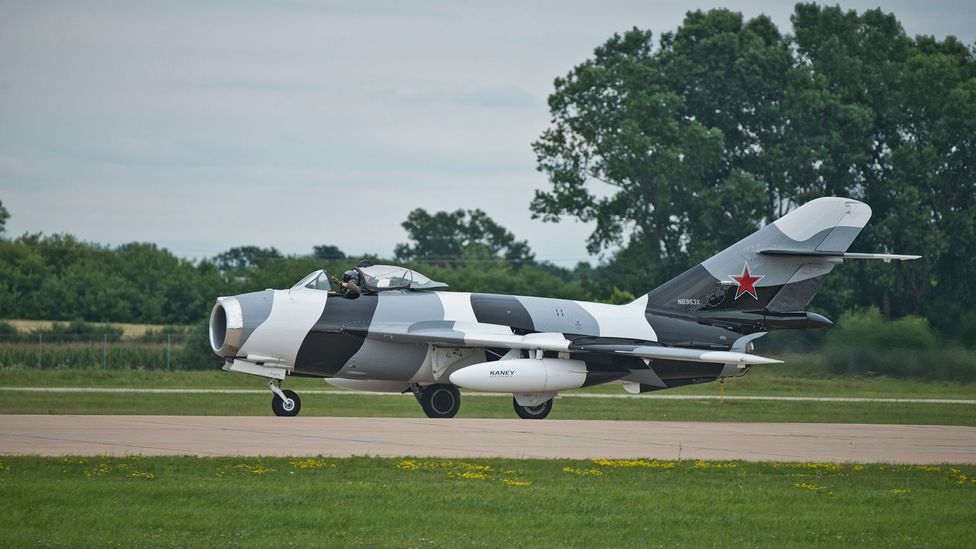
The MiG-17 was operated by North Vietnam in the Vietnamese War, and proved a dangerous opponent for US fighters.
During the 1960s, the US had embraced the new technology of air-to-air missile as the best weapon to shoot down enemy aircraft. When the Vietnam War began in 1965, some of its frontline fighter aircraft, such as the F-4 Phantom II, did not have guns; US military planners believed the plane's missiles would be enough.
The missile-armed American fighters, however, came up against small and agile Soviet-made MiG fighters as the war in Vietnam developed. Some of North Vietnam's MiGs were virtually identical to Soviet fighters that had fought over the Korean peninsula in the early 1950s, and were now considered almost laughingly obsolete in the West. In close-quarters combat, however, where American fighters couldn't bring their missiles to bear, they could be formidable opponents.
Between 1965 and 1968, America's fighters still shot down more North Vietnamese fighters than they were losing, but the gap dramatically narrowed. The big, twin-engined American fighters were easier to spot from a distance; the small, single-engined MiGs were not.
One solution was to set up training schools like the US Navy's "Top Gun", which taught US aviators the lost art of dogfighting; this came into operation before the end of the Vietnam War, and vastly improved the American kill-to-loss ratio. Dogfighting had started in World War One, in small aircraft barely faster than a family car. Similar combat in jets capable of flying at several hundred miles an hour is a completely different experience – the high speed means you are subjected to the higher gravitational forces, or G-force, in a tight turn for longer.
But another was a more ambitious programme designed to counter increasingly improved Soviet aircraft. US defence chiefs had already been alarmed, at the end of the 1960s, by the emergence of the Soviet MiG-25, a giant fighter aircraft which could fly at three times the speed of sound. (See BBC Future's article: The pilot who stole a secret Soviet jet.)
The Pentagon's call for a powerful interceptor to counter the MiG-25 led to the McDonnell-Douglas F-15 Eagle, a large and fast interceptor designed to shoot down enemy aircraft at high altitude with radar-guided missiles. But the Soviet Union and its Warsaw Pact allies like Poland and East Germany fielded thousands more combat aircraft that would fly and fight at lower level.
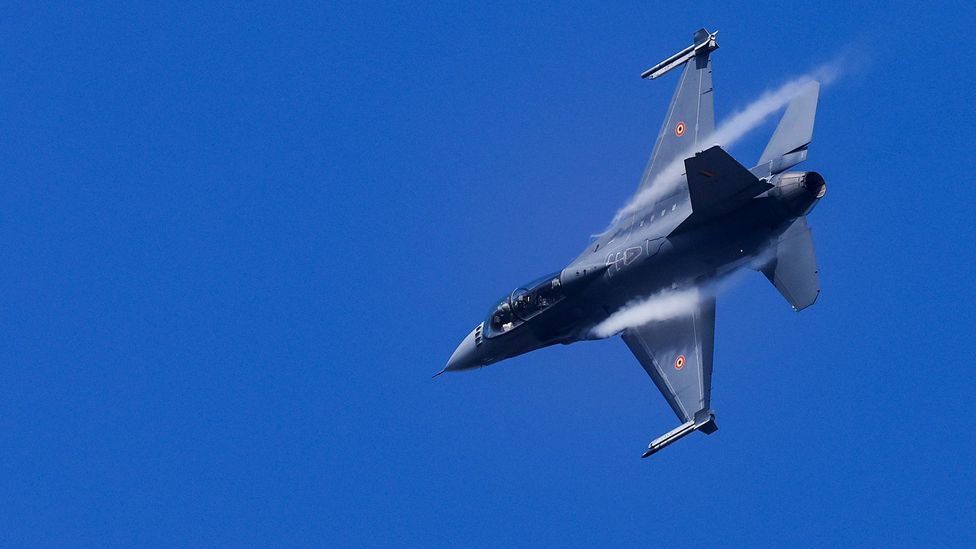
The F-16’s ability to pull 9g exerts huge strain on both the airframe and the pilot.
What was also needed was a small, agile aircraft that could shoot down enemy planes with heatseeking missiles and a gun – a direct learning from the hard lessons of the Vietnam war.
The USAF would need many hundreds of such fighters, and there was the strong possibility that Nato countries and other US allies around the globe would then follow suit. Five designs ended up in contention for this lucrative project, with two quickly emerging as the frontrunners – the YF-16 from General Dynamics (now part of Lockheed-Martin) and the YF-17 from rival Northrop.
The YF-16 was built to dogfight first and foremost, and that directly influenced aspects of its design, including its cockpit canopy. The pilot would sit in a raised cockpit with a huge canopy that offered almost unrivalled view – similar to early jet fighters that had been replaced by missile-armed fighters. "At least part of the 'fighter mafia' that were pushing it were looking back to Korea and the F-86 Sabre," says Tim Robinson, a military aviation specialist at the Royal Aeronautical Society in the UK. "They were looking at something that was really manoeuvrable and had really great vision for the pilot with a bubble canopy."
One idea that was proposed, Robinson continues, was to do away with a radar completely. "The idea would be to have two infrared-seeking missiles and a gun. And they would have to churn these things out. They were looking at the numbers of Soviet aircraft and were thinking: 'Gosh, we're going to need lots of these, we have to build lots and lots of them'."
The new jet wouldn't need the long range of the F-15, so could be a lot smaller and lighter and would only need one engine to the F-15's two. That combination of low weight and a powerful engine creates a high "thrust-to-weight ratio", which not only enabled high speed but the ability to turn sharply – perfect for dogfighting.
The F-16 was designed to withstand up to 9G in a dogfight (which means anything that would weigh 1kg on the ground suddenly weighs 9kg). Flying at high-G generates enormous stress on both the airframe and the pilot. The F-4 by comparison, could pull 7G, but not for long as its heavier airframe bled speed and height much more quickly.
In order to help the pilot keep conscious in high-G turns, the cockpit seat in the F16 is reclined, which helps dampen some of the effects on the pilot. Jeff Bolton is an aviation journalist and broadcaster who has twice flown in a two-seat version of the F-16, used for both pilot training and specialised missions. "More than any other fighter I've flown in, by far, it is a glove, it is literally like putting on a leather driving glove when you get in it," he says. "I'm almost 6ft 4in (1.9m), so it's a tight, tight fit for me, but I could still lower my seat all the way, and I could get my hand in between my helmet and the canopy. And there's, I guess, a recognition from your body that you're 'wearing' the aeroplane."
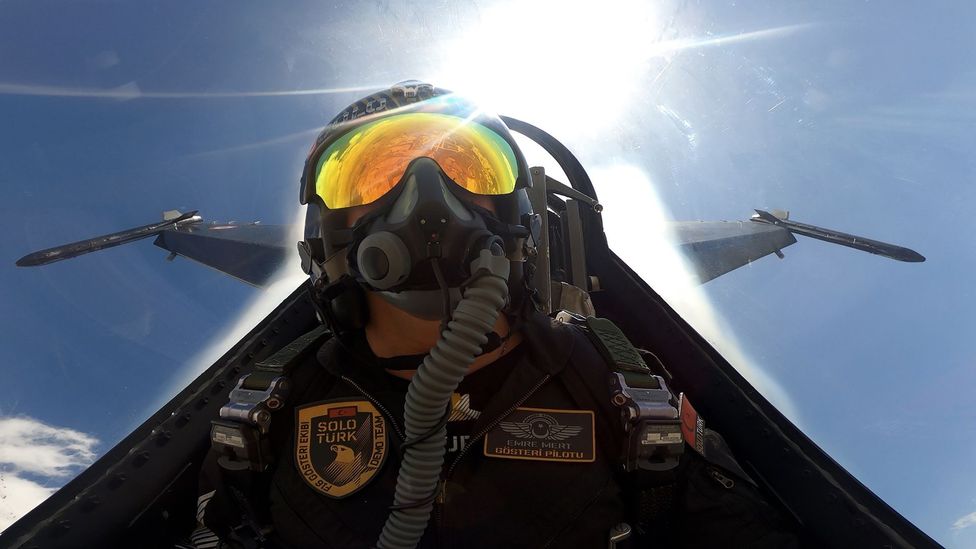
F-16 pilots sit on a reclined seat which helps dampen the effects of high-g turns.
The F-16's cockpit design went far further than just a reclined seat and a good view. The plane's designers did away with one of the most central features of fighter planes since World War One – a control stick between the pilot's legs. Instead, the F-16 had a joystick-style controller on the right side of the cockpit, much like one you'd use on a computer game flight simulator.
This controller – at least in the first examples of the F-16 – didn't move as the pilot applied force to it. This was because the F-16 was partly being flown by a flight computer making constant small adjustments to the aircraft's control surfaces – a system we now know as "fly-by-wire". It was the first aircraft in the world to use it. It is now found in most modern airliners, such as the Boeing 777 and Airbus A320.
"We now take fly-by-wire for granted," says Robinson. "Now you see fly-by-wire everywhere. A small consumer drone that's got fly-by-wire, people fly on fly-by-wire airliners. 'Electric Jet' was one of the one of the nicknames [of the F-16] and yeah, I think there was probably some resistance in some quarters taking the pilot out of the equation."
The F-16 was originally built to compliment the F-15 at lower altitudes, but it was soon found that – much like the World War Two Supermarine Spitfire – the F-16's airframe allowed it to carry heavier loads, more fuel and a bigger radar. "The F-16 is almost an utterly perfect Swiss Army knife," says Bolton.
The F-16 has, in the 21st Century, become equally important as a ground attack aircraft – not something its designers had on their drawing boards in the early 1970s. That adaptability allowed it to carry out more and more roles, which made it increasingly attractive to air forces. "Where there's a conflict, there's probably an F-16 involved somewhere," says Robinson.
The original nickname for the F-16 was the "Fighting Falcon", but the name never stuck, says Robinson. "Nobody ever uses it. They call it the Viper, the reason being it came out in the late 70s the same time as [TV series] Battlestar Galactica. It looks like a Colonial Viper," Robinson says, referring to the spaceships featured in the show. "It still looks like it belongs in the future."
Parked on the ground, the F-16 looked futuristic. But in the air, it could be a revelation, even for pilots with plenty of fast-jet experience. "There were instances where pilots were 'G-locking' [blacking out in high-G situations]," says Robinson. "It was an aircraft that could push pilots beyond their physiological limits not only because it was 9G but also how fast that would come on."
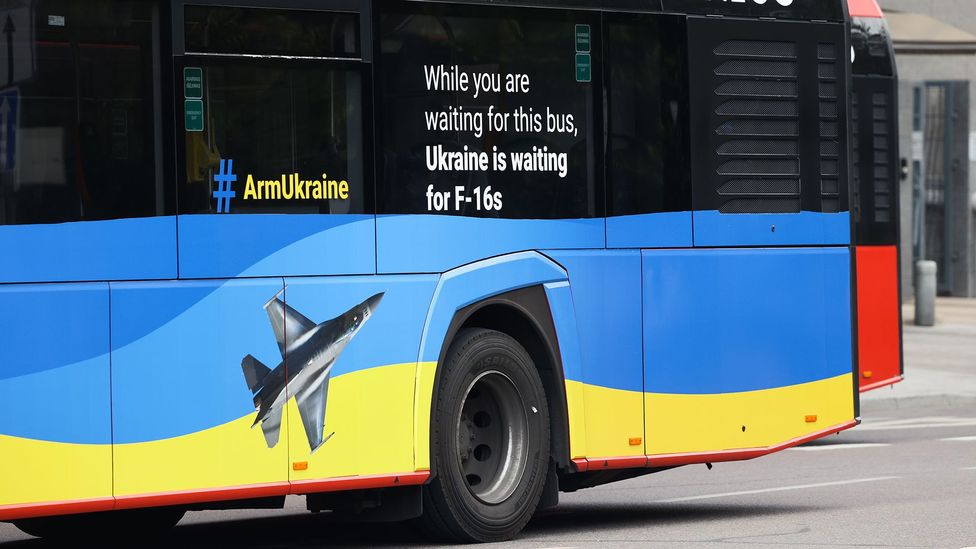
Ukraine's air force is expected to take delivery of its first F-16s in the summer.
Bolton has experienced just that in one of his flights in an F-16. Only a small amount of force is needed on the F-16's controller for it to respond. "Its tiny little control inputs, little, little inputs, but the next thing you know, you've got 9G on your chest. So if you're 220lb (100kg) like I am, times that by nine. The whole world at that point is laying on top of you."
The F-16 is often described by pilots as very easy to fly, partly thanks to the fly-by-wire system, and partly because of its strong airframe, with big lift-generating wings.
"When I flew it the first time, [the pilot] said to me, 'Hey, all right, your jet'," says Bolton, meaning the pilot had given him control of the aircraft. The pilot gave Bolton some advice. "It's very sensitive. So just keep that in mind.'" Bolton says he started with an aileron roll, where the aircraft rolls 360 degrees without losing altitude, careful not to exert too much force on the F-16's control stick.
"So I executed that. And he looks up at me and he goes, 'Dude, that was great.'" The instructor said that student pilots would at first put too much force onto the F-16's controller. The plane is so responsive "it slams the instructors head off the sides of the canopy", says Bolton.
There's a lot of sensory overload… the heat, the jet noise – John Waters
Bolton has flown in earlier US military jets, such as the Northrop F-5, which for a long time was used to play the role of Soviet jets in Top Gun exercises. "Talk about old school, you know that thing is great, a little like an MG sports car with a Corvette motor in it." But the F-5, which used to fill similar roles to the F-16 in many air forces, is a more "analogue airplane". Its small cockpit doesn't offer anything like the F-16's visibility. "You're out over the [front landing] gear so you can see over the nose as the ground falls away from you as you take off," says Bolton of the F-16's cockpit. "
John Waters is someone who knows that view very well. Now a Boeing 777 pilot and podcaster who runs the Afterburn aviation podcast, he started flying F-16s for the USAF in 2013. He flew ground attack missions in Syria against Isis and trained for particularly dangerous missions called SEAD (Suppression of Enemy Air Defence), hunting for ground-based missile sites, which pilots nicknamed "Wild Weasel". These F-16s would be able to launch a radar-guided missile at an enemy fighter far beyond visual range, drop a guided bomb at a target on the ground and fire a radiation-seeking missile to home in on an enemy radar site – all at the same time. Waters did all three in training. "If you had all three of those in the air at one time, you were doing the 'Wild Weasel' deal to its fullest," he says.
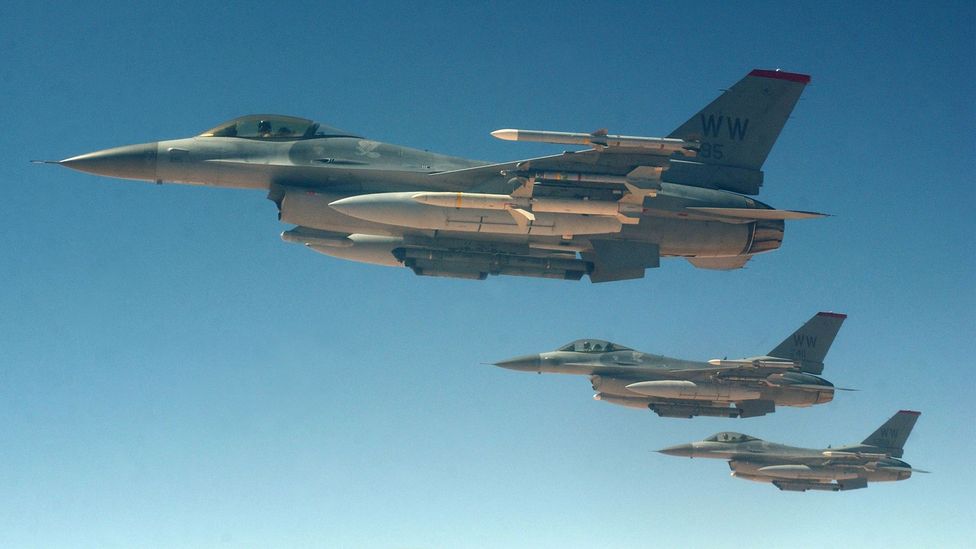
One of the most dangerous missions F-16s currently carry out is hunting enemy ground-based missiles, which pilots nickname “Wild Weasels”.
Towards the end of his F-16 flying career, however, Waters was flying demonstration flights and aerobatic routines at air shows. (You can see one of his air show displays in 2018 here, captured on a camera in the cockpit.)
He can still remember the first time he strapped into the F-16's cockpit. "It was July in Phoenix, and it was 119F (48C)," he tells the BBC. "There's a lot of sensory overload… the heat, the jet noise… you're jumping into a plane that you've only been in the simulator for a few times, in a controlled comfortable environment." Waters says that about 5,000ft (1.5km) up he dropped his mask and that he was drenched with sweat, both from the heat and the excitement flying the F-16 for the first time. "I just took a minute to enjoy the moment. It’s a pretty incredible sensation, pushing that power up. And at that time, the absolute most powerful thing I'd flown."
Waters' YouTube channel is full of Go-Pro footage of him taking his F-16 off a runway into finely planned airshow routines. He would don wearable tech which monitored his heart rate. "In a 15-minute profile, I would burn anywhere from 300 to 600 calories all the way up until the end, but if it was hot outside? The F-16 has a decent environmental cooling system (ECS), but it is really there to cool the radar and the avionics and it doesn't work great until you get up at altitude."
The only tricky part of flying the F-16, Waters says, is landing it. "Landing it well, it's not always an easy thing, because it wants to keep flying. You see F-16's do what we call a 'bubble' or a 'bounce'. You can't stall it traditionally, the fly-by-wire does not want you to do that, it wants to keep it flying."
Waters stopped flying the F-16 in 2019. "I still miss it. Nothing beats strapping on the F-16. It's like you're on the end of a telephone pole with a rocket motor strapped to your back."
The F-16 is in the process of being replaced in the US and some Nato air forces by another Lockheed-made fighter, the F-35. Each F-35 costs more than $100m (£81m) and is designed to destroy enemy planes with long-range missiles, long before the F-35 is ever picked up on their radars. An F-16 without add-ons might only cost a third of that price.
No comments:
Post a Comment